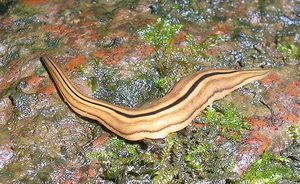Turbellarians: Turbellaria
Freshwater Planarian (dugesia Tigrina): Species Accounts

Physical characteristics: The body of the freshwater planarian is lance shaped with ear-shaped structures on each side of the head. These worms are light to dark brown, and some forms have a stripe down the center of the back. This worm has midline, light spots on a dark background or dark spots on a light background. The large mouth is in the middle of the body.
Geographic range: Freshwater planarians live all over North America and are scattered in Europe, where they may have been introduced with water plants.
Habitat: Freshwater planarians live under rocks, plants, and debris in clear freshwater ponds, streams, and springs.
When hunting, freshwater planarians swing their heads from side to side better to sense sources of chemicals coming from food or prey.
Diet: Freshwater planarians eat various invertebrates, including mosquito larvae.
Behavior and reproduction: Freshwater planarians hide under rocks during the day. When hunting they swing their head from side to side better to sense sources of chemicals coming from food or prey. Freshwater planarians use asexual reproduction by splitting from side to side. Freshwater planarians have a strong capacity for regrowing after splitting. Scientists have not found reproductive organs in some of these worms and believe splitting may be more common than sexual reproduction. When they do mate, each worm deposits several egg capsules. Freshwater planarians do not have larvae. Young worms hatch from eggs.
Freshwater planarians and people: Freshwater planarians are studied intensively as a model for cell regrowth in humans and other animals.
Conservation status: Freshwater planarians are not threatened or endangered. ∎
Additional topics
- Turbellarians: Turbellaria - No Common Name (notoplana Acticola): Species Accounts
- Turbellarians: Turbellaria - Behavior And Reproduction
- Other Free Encyclopedias
Animal Life ResourceJellyfish, Sponges, and Other Simple AnimalsTurbellarians: Turbellaria - Physical Characteristics, Habitat, Diet, Behavior And Reproduction, Freshwater Planarian (dugesia Tigrina): Species Accounts - GEOGRAPHIC RANGE, TURBELLARIANS AND PEOPLE, CONSERVATION STATUS